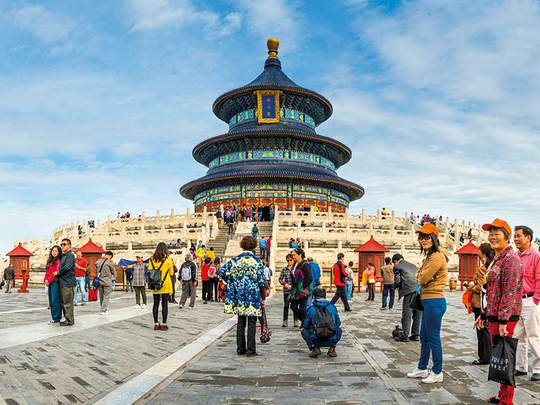
For hundreds of years, commoners were barred from entering it. Today, the Forbidden City is one of the most visited tourist attractions in the world, with visitors numbers topping 16 million last year.
Located in the heart of Beijing, the former imperial complex is where 24 emperors from two dynasties lived for nearly 500 years. The complex, also known as the Former Palace in Chinese, also houses a museum, with a massive collection of paintings, calligraphy, ceramics and antiquities from the imperial collection.
“We have in China 4,700 museums, [but] very few collect foreign objects. Palace Museum is an exception, and it has tens of thousands of foreign objects,” says Shan Jixiang, the director of the Palace Museum.
It’s the “biggest place in terms of art pieces in the world,” he adds
More than 1.17 million pieces of art are estimated to be housed at the museum, with many travelling to nearly 135 exhibitions around the world. Shan expressed hope that the Louvre Museum Abu Dhabi would soon host an exhibition of the Chinese art, and that the UAE’s art will be on display at his museum.
Art and artefacts from around the world, including countries such as India, France, Afghanistan, Greece and Monaco, have also found a place here. “This Imperial Palace is a global platform for people from around the world to come and exhibit their arts and display their cultures,” says Shan.
The Forbidden City, which was opened to the public in the first half of the past century, was declared a Unesco world heritage site in 1987 as the Imperial Palace of the Ming and Qing Dynasties due to its significant place in the development of Chinese architecture and culture.
Initially, only 30 per cent of the complex was accessible to visitors. Today, almost 80 per cent of the total area of the tourist attraction is open to visitors.
The Palace Museum is currently on a 16-year restoration project that started in 2002 and is expected to continue until 2020. The plan is to complete all works in time for the 600th anniversary of the Forbidden City.
The cost of the renovation is estimated at $150,00 (Dh551,000) a year, Shan says, adding: “The goal of all the renovation is to preserve the beauty of the place since its early years.”
The renovation plan includes introducing earthquakes resistance measures to the underground buildings of the Palace. It also includes lightening protection systems as “fires constitute our biggest fears, as most of the buildings are built of wood,” Shan points out.
Already the museum is listed by Unesco as the largest collection of preserved ancient wooden structures in the world.
Meanwhile, seasonal rain do not constitute a source of concern, because of the efficient draining pipes system that was built with the Palace nearly 500 years ago.
THE FORBIDDEN CITY COMPLEX
The complex of the Forbidden city, which was constructed from 1406 to 1420, according to the Chinese palatial architecture, comprises of 980 buildings, with thousands of rooms. Some researches put the number of rooms at 8,886, while some estimate it at around 9,999. The complex is a rectangle 961 metres from north to south and 753 metres from east to west. It was built on an area that spreads more than 72 hectares, and designed to be the centre of the ancient walled city of Beijing. It served as the palace from the Ming dynasty from 1420 to the end of the Qing dynasty in 1912.
HOW TO GET THERE
Emirates has 38 direct flights to different Chinese cities a week, plus four flights a week to Hong Kong. This includes two flights from Dubai to Beijing on an A380.
Etihad has daily direct flights to Chinese cities, namely Beijing and Shanghai, including one flight daily between Abu-Dhabi and Beijing.







